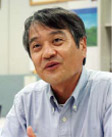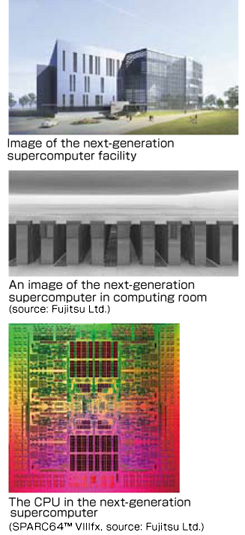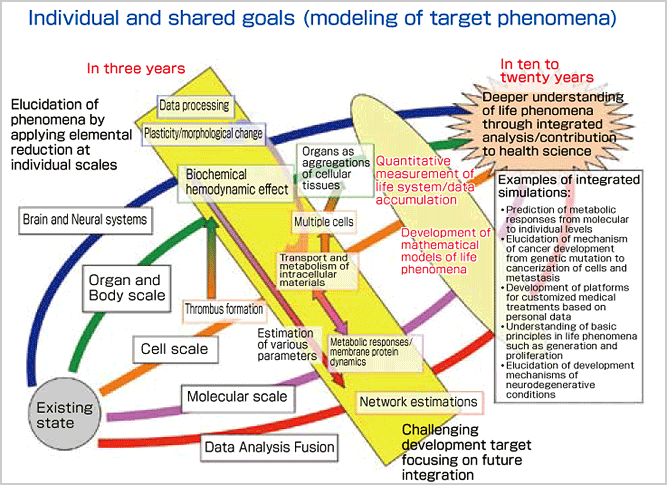
Bio-supercomputing:
A Critical Component in the Future of Life Science Research
Innovative Approach for Understanding Phenomena of Life
Exploring New Possibilities with Bio-supercomputing
Concurrent with the research and development of a world-leading, maximum performance, next-generation supercomputer, steady progress is also being made with the application software that will take full advantage of such a computer's superior capabilities. In collaboration with a number of researchers, RIKEN, as the research and development base for the "Grand Challenge" application in the life sciences, which is part of the Next-Generation Supercomputer Project, is undertaking the "Research and Development of Next-Generation Integrated Life-Science Simulation" program and advocates the science of" bio-supercomputing," a new academic field. We asked Dr. Himeno, Deputy Program Director, to share his views as to how the world of life science will change and evolve with the emergence of bio-supercomputing.

Computational Science Research Program
Deputy Program Director
Ryutaro HIMENO
Until recently, supercomputers were used only in limited areas in the life sciences. Today, however, supercomputers enabling highly-sophisticated simulations are becoming a reality in new areas such as studies of various structure changes of protein or blood circulation. In the meantime, against the backdrop of a significant performance improvement in testing equipment over the last decade, the need for bigger computing resources and superior software capable of analyzing a vast amount of experimental data is increasingly being recognized. The advanced computing capabilities of a next-generation supercomputer will most definitely benefit areas of study that require such mass data analysis. Furthermore, we consider the "Next-Generation Supercomputer" project a great opportunity to sow the seeds to expand the use of supercomputers in other areas in the life sciences that have so far not required them.

Generally, researchers tend to narrow in on a single phenomenon in a sophisticated, detailed and keen manner. Likewise, studies in the life sciences have also been moving toward unraveling mechanisms by focusing on a single element of natural phenomena, such as proteins or genes. Such an approach alone, however, cannot explain a phenomenon in its entirety. The motion of atoms and molecules, for example, basically follows the laws of physics. This behavior could be described perfectly using equations from quantum chemistry and molecular dynamics. It is not so straightforward, however, when it comes to a phenomenon within a cell, as it involves highlycomplex interactions between many molecules. Furthermore, different reactions can occur simultaneously depending on locations within the cell. What we call natural phenomena are not small individual reactions or elements. Rather, these are phenomena that perform essential functions such as the creation of tissues and organs through cellular division. That is what life is. One cannot complete a picture of life by simply putting together the pieces of a jigsaw puzzle. What I believe we need is an approach that connects the pieces by integrating elements from all hierarchies, while remaining focused on the entire picture. Our focus has now shifted from analyzing elements to gaining a comprehensive understanding of life, by shifting from an empirically-defined model to one based on invariable principles.
I would like this project to be a forum for bringing researchers together to connect the individual pieces that each researcher has worked very hard to uncover. Opportunities for a molecular biophysicist and a medical practitioner to meet and have discussions have to date been quite rare. The project can provide a roundtable for people who have been isolated in various research specialties in their individual quests for answers to use as a starting point for new discoveries and the creation of new methodologies. This roundtable is what we call "bio-supercomputing." Drawing in diverse individuals under the identity of "bio-supercomputing" would cultivate a deeper awareness of being in a shared place and together we can explore and develop a new field of science. Needless to say, it would be difficult to achieve such goals with researchers in the life sciences alone. Collaboration with computer science researchers is vital for success. Furthermore, opening participation to an even broader scope of specialists will be an amazing opportunity that can leads us in new directions. Scientists in astronomy and elementary particles, for example, will be able to interconnect hierarchies in the phenomena of life at the mathematical level.
There are two internationally-acknowledged keywords in the life sciences today: "multi-scale" and "integration." The multi-scale method relates microscale to macro-scale. It is a universally-pursued approach in which models of different scale are integrated through the creation of new models that employ and interlock these models. In brain science, for example, simulation studies have been initiated to apply multiple scales comprehensively at one part of the human body. Our "Research and Development of Next- Generation Integrated Life-Science Simulation" program is a unique in the world, however, as it aims to integrate every phenomenon within living organisms ranging from the molecular level to the entire system.

This is an extremely difficult undertaking, as life is all too complex and diverse. Truth be told, conducting a project that focuses on a single phenomenon of life would be more likely to produce a result with a bigger scientific impact. The goal of this particular program, however, is not merely to produce short-term achievements. As development projects utilizing next-generation supercomputers continue to make further progress, studies in the life sciences are also ongoing and will be carried through into the future. Creating a specialized model designed solely around a specific aspect means the loss of universality with no possibility for further expansion. Our six teams, which focus on different themes such as molecular and cellular scales, are currently tackling several software applications and issues in parallel efforts. Although they may appear to be heading toward different goals, this is because we are pursuing subjects in the order in which the data required for model development and simulation testing are sufficiently available. In the near future, when all the other data are available, individual achievements by the research and development teams for various scales will be applied in a collaborative effort. I envision that is how the project will eventually lead us to a comprehensive understanding of the phenomena of life. For the success of the project, it is important that, in partnerships reaching beyond Japan's borders, we source software that can be standardized globally and accumulate our knowledge as a shared asset of all humanity.
BioSupercomputing Newsletter Vol.1
- SPECIAL INTERVIEW
- Innovative Approach for Understanding Phenomena of Life Exploring New Possibilities with Bio-supercomputing
Computational Science Research Program Deputy Program Director Ryutaro HIMENO
- A Message from the Team Leader
- Simulations to Understand the Functions of the Biopolymers that Play Fundamental Roles in Life
Molecular Scale Team Team Leader Akinori KIDERA - Develop a 3-D Model of the Entire Human Body and Understand In Vivo Phenomena to Utilize for Medical Purposes
Organ and Body Scale Team Team Leader Shu TAKAGI - The Fourth Methodology (Data Analysis Fusion): Transforming Biology into a Predictable Science
Data Analysis Fusion Team Team Leader Satoru MIYANO
- Report on Research
- Prediction of Transmembrane Dimer Structure of Amyloid Precursor Protein using Replica-Exchange Molecular Dynamics Simulations
Molecular Scale Team Naoyuki MIYASHITA / RIKEN Advanced Science Institute (Molecular Scale WG) Yuji SUGITA - Simulation for Charged Particle Therapy
Organ and Body Scale Team Kenichi L. ISHIKAWA - Prospects of Prognostic Prediction Based on Genome-wide Association Study and Genetic/Non-genetic Factors
Riken Center for Genomic Medicine (Data Analysis Fusion WG) Naoyuki KAMATANI - Key Technology Supporting Petascale Computing
High-performance Computing Team Kenji ONO / Satoshi ITO / Daisuke WATANABE
